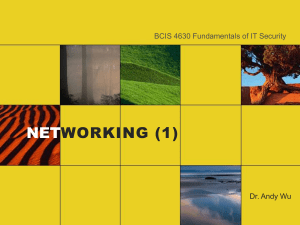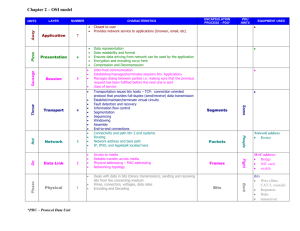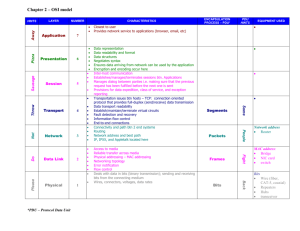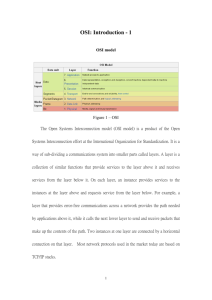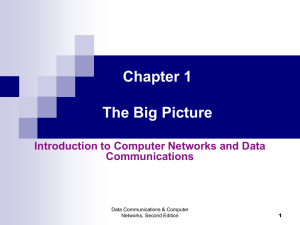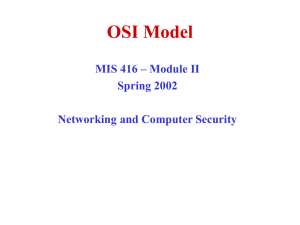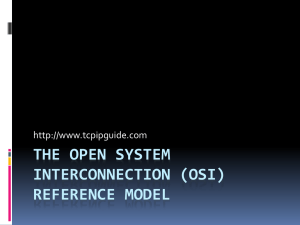Unit 2
advertisement
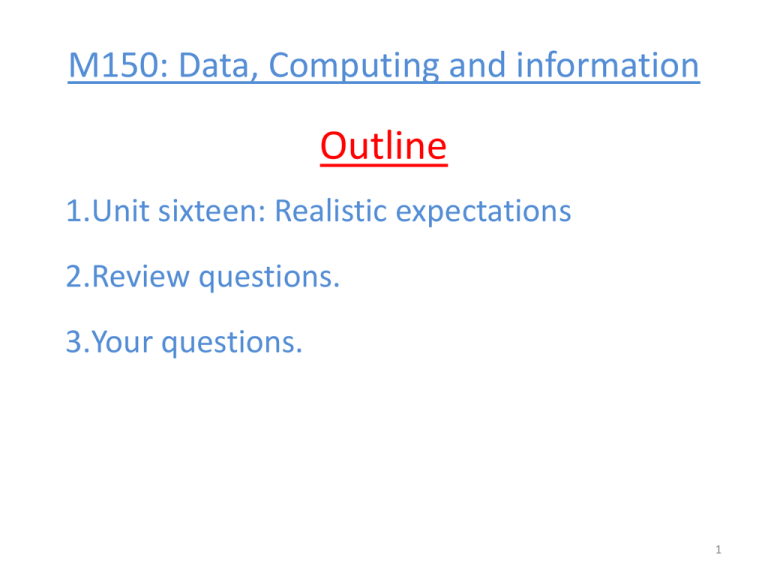
M150: Data, Computing and information Outline 1.Unit sixteen: Realistic expectations 2.Review questions. 3.Your questions. 1 1- Unit sixteen: Introduction In this Unit: The digital computer, the success of the twentieth century Reaction to the rise of ICT What can go wrong with computer applications What computers cannot do or should not do Ethics and computing 2 The digital computer, the success of the twentieth century The invisible computer The story is similar to “home electric motor” of the early 19th Interesting tools: the GPS Parallel computing Moore’s law: interesting expectations 3 The OSI Model 4 OSI model Layers Layer 1. Physical Layer: Defines the physical [hardware] implementation and the electrical [signal level] implementation of the bus; network cabling, connector type, pin-out, physical data rates, maximum transmission distances, and data transmission encoding. 5 OSI model Layers Layer 2. Data Link layer: Frame format, Transmitting frames over the net [additional bit/byte stuffing, start / stop flags, checksum, and CRC]. CAN bus, ATM, StarLAN, LocalTalk and HDLC are layer 2 protocols. Different network and protocol characteristics are defined by different data link layer specifications. 6 OSI model Layers Layer 3. Network Layer: Provides address assignment, and Packet's forwarding methods. Protocol Data Unit [PDU] is called a Packet at this layer. This layer responds to service requests from the Transport Layer and issues service requests to the Data Link Layer. 7 OSI model Layers Layer 4. Transport Layer: Provides transfer correctness, data recovery, and flow control. TCP is a layer 4 protocol. Protocol Data Unit [PDU] is called a Segment at this layer. This layer responds to service requests from the Session Layer and issues service requests to the Network Layer. 8 OSI model Layers Layer 5. Session Layer: Establishing a communication session, Security, Authentication. NetBIOS is a layer 5 protocol. Protocol Data Unit [PDU] is called Data at this layer. This layer responds to service requests from the Presentation Layer and issues service requests to the Transport Layer. 9 OSI model Layers Layer 6. Presentation Layer: Determines how computers represent data [ASCII, GIF..]. Protocol Data Unit [PDU] is called Data at this layer. This layer responds to service requests from the Application Layer and issues service requests to the Session Layer. 10 OSI model Layers Layer 7. Application Layer: The highest layer. Generates or interprets data, may also provide encryption or decryption. Applications using the network learn how to send a request, how to specify a filename over the net, how to respond to a request. 11 The responses of individuals The optimists The pessimists The realists 12 What can go wrong Dependence and risk Hardware failure Software crisis (the Y2K exemplary) Inadequate requirements Incorrect coding Infeasibility of testing 13 What can go wrong Inadequate models Over maintained code The swing project 14 Inadequate model The Swing project This is how the customer explained it 915 This is how the project Leader understood it 10 16 This is how the engineer designed it 11 17 This is how the programmer wrote it 12 18 This is how the sales executive described it 13 19 This is how the project was documented 14 20 These are the installed components 15 21 This is how the customer was billed 16 22 This is how the helpdesk supported it 17 23 This is what the customer really needed 18 24 What computers cannot do Not everything is quantifiable Limitation on accuracy of representation Approximation of the reality Human behavior vs explicit rules Advanced e-thinking: computer playing chess. 25 What computers should not do It should not: Remove humans from the control loop Replace human knowledge and experience Take the human role 26 Ethics and computing Ethics in the context of ICT Ethics and computing profession The persuasive computer 27 Review questions How many layers the OSI model has ? Name three layers of the OSI model Give an example of hardware failure Give an example of software failure implications Provide three examples of what computers cannot do Do you think that someday we will be able to Humanize computers? Discuss. 28 3- Your questions 29


